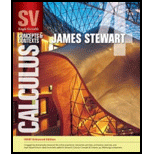
Single Variable Calculus: Concepts and Contexts, Enhanced Edition
4th Edition
ISBN: 9781337687805
Author: James Stewart
Publisher: Cengage Learning
expand_more
expand_more
format_list_bulleted
Question
Chapter A, Problem 34E
To determine
To solve: The inequality.
Expert Solution & Answer
Answer to Problem 34E
The interval notation for the given inequality is
Explanation of Solution
Given:
The inequality is
Property used:
Calculation:
By the property mentioned above, the given function can be re written as,
The corresponding interval notation is
Thus, the interval notation for the given inequality is
Chapter A Solutions
Single Variable Calculus: Concepts and Contexts, Enhanced Edition
Ch. A - Prob. 1ECh. A - Prob. 2ECh. A - Rewrite the expression without using the...Ch. A - Prob. 4ECh. A - Prob. 5ECh. A - Prob. 6ECh. A - Rewrite the expression without using the...Ch. A - Prob. 8ECh. A - Prob. 9ECh. A - Prob. 10E
Ch. A - Prob. 11ECh. A - Prob. 12ECh. A - Prob. 13ECh. A - Prob. 14ECh. A - Prob. 15ECh. A - Prob. 16ECh. A - Prob. 17ECh. A - Prob. 18ECh. A - Prob. 19ECh. A - Prob. 20ECh. A - Prob. 21ECh. A - Prob. 22ECh. A - Prob. 23ECh. A - Prob. 24ECh. A - Prob. 25ECh. A - Prob. 26ECh. A - The relationship between the Celsius and...Ch. A - Prob. 28ECh. A - As dry air moves upward, it expands and in so...Ch. A - Prob. 30ECh. A - Prob. 31ECh. A - Prob. 32ECh. A - Prob. 33ECh. A - Prob. 34ECh. A - Prob. 35ECh. A - Prob. 36ECh. A - Prob. 37ECh. A - Prob. 38ECh. A - Prob. 39ECh. A - Prob. 40ECh. A - Prob. 41ECh. A - Prob. 42ECh. A - Prob. 43ECh. A - Prob. 44E
Knowledge Booster
Learn more about
Need a deep-dive on the concept behind this application? Look no further. Learn more about this topic, calculus and related others by exploring similar questions and additional content below.Similar questions
arrow_back_ios
SEE MORE QUESTIONS
arrow_forward_ios
Recommended textbooks for you
 Calculus: Early TranscendentalsCalculusISBN:9781285741550Author:James StewartPublisher:Cengage Learning
Calculus: Early TranscendentalsCalculusISBN:9781285741550Author:James StewartPublisher:Cengage Learning Thomas' Calculus (14th Edition)CalculusISBN:9780134438986Author:Joel R. Hass, Christopher E. Heil, Maurice D. WeirPublisher:PEARSON
Thomas' Calculus (14th Edition)CalculusISBN:9780134438986Author:Joel R. Hass, Christopher E. Heil, Maurice D. WeirPublisher:PEARSON Calculus: Early Transcendentals (3rd Edition)CalculusISBN:9780134763644Author:William L. Briggs, Lyle Cochran, Bernard Gillett, Eric SchulzPublisher:PEARSON
Calculus: Early Transcendentals (3rd Edition)CalculusISBN:9780134763644Author:William L. Briggs, Lyle Cochran, Bernard Gillett, Eric SchulzPublisher:PEARSON Calculus: Early TranscendentalsCalculusISBN:9781319050740Author:Jon Rogawski, Colin Adams, Robert FranzosaPublisher:W. H. Freeman
Calculus: Early TranscendentalsCalculusISBN:9781319050740Author:Jon Rogawski, Colin Adams, Robert FranzosaPublisher:W. H. Freeman
 Calculus: Early Transcendental FunctionsCalculusISBN:9781337552516Author:Ron Larson, Bruce H. EdwardsPublisher:Cengage Learning
Calculus: Early Transcendental FunctionsCalculusISBN:9781337552516Author:Ron Larson, Bruce H. EdwardsPublisher:Cengage Learning

Calculus: Early Transcendentals
Calculus
ISBN:9781285741550
Author:James Stewart
Publisher:Cengage Learning

Thomas' Calculus (14th Edition)
Calculus
ISBN:9780134438986
Author:Joel R. Hass, Christopher E. Heil, Maurice D. Weir
Publisher:PEARSON

Calculus: Early Transcendentals (3rd Edition)
Calculus
ISBN:9780134763644
Author:William L. Briggs, Lyle Cochran, Bernard Gillett, Eric Schulz
Publisher:PEARSON

Calculus: Early Transcendentals
Calculus
ISBN:9781319050740
Author:Jon Rogawski, Colin Adams, Robert Franzosa
Publisher:W. H. Freeman


Calculus: Early Transcendental Functions
Calculus
ISBN:9781337552516
Author:Ron Larson, Bruce H. Edwards
Publisher:Cengage Learning
2.1 Introduction to inequalities; Author: Oli Notes;https://www.youtube.com/watch?v=D6erN5YTlXE;License: Standard YouTube License, CC-BY
GCSE Maths - What are Inequalities? (Inequalities Part 1) #56; Author: Cognito;https://www.youtube.com/watch?v=e_tY6X5PwWw;License: Standard YouTube License, CC-BY
Introduction to Inequalities | Inequality Symbols | Testing Solutions for Inequalities; Author: Scam Squad Math;https://www.youtube.com/watch?v=paZSN7sV1R8;License: Standard YouTube License, CC-BY